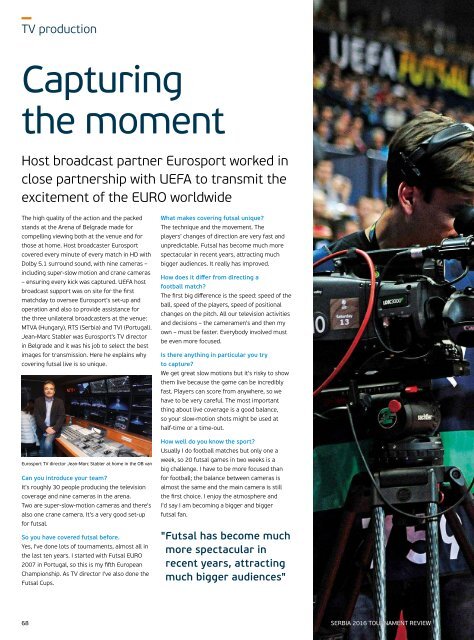Tournament review
2363707_DOWNLOAD
2363707_DOWNLOAD
You also want an ePaper? Increase the reach of your titles
YUMPU automatically turns print PDFs into web optimized ePapers that Google loves.
TV production<br />
Capturing<br />
the moment<br />
Host broadcast partner Eurosport worked in<br />
close partnership with UEFA to transmit the<br />
excitement of the EURO worldwide<br />
The high quality of the action and the packed<br />
stands at the Arena of Belgrade made for<br />
compelling viewing both at the venue and for<br />
those at home. Host broadcaster Eurosport<br />
covered every minute of every match in HD with<br />
Dolby 5.1 surround sound, with nine cameras –<br />
including super-slow motion and crane cameras<br />
– ensuring every kick was captured. UEFA host<br />
broadcast support was on site for the first<br />
matchday to oversee Eurosport's set-up and<br />
operation and also to provide assistance for<br />
the three unilateral broadcasters at the venue:<br />
MTVA (Hungary), RTS (Serbia) and TVI (Portugal).<br />
Jean-Marc Stabler was Eurosport's TV director<br />
in Belgrade and it was his job to select the best<br />
images for transmission. Here he explains why<br />
covering futsal live is so unique.<br />
Eurosport TV director Jean-Marc Stabler at home in the OB van<br />
Can you introduce your team?<br />
It's roughly 30 people producing the television<br />
coverage and nine cameras in the arena.<br />
Two are super-slow-motion cameras and there's<br />
also one crane camera. It's a very good set-up<br />
for futsal.<br />
So you have covered futsal before.<br />
Yes, I've done lots of tournaments, almost all in<br />
the last ten years. I started with Futsal EURO<br />
2007 in Portugal, so this is my fifth European<br />
Championship. As TV director I've also done the<br />
Futsal Cups.<br />
What makes covering futsal unique?<br />
The technique and the movement. The<br />
players' changes of direction are very fast and<br />
unpredictable. Futsal has become much more<br />
spectacular in recent years, attracting much<br />
bigger audiences. It really has improved.<br />
How does it differ from directing a<br />
football match?<br />
The first big difference is the speed: speed of the<br />
ball, speed of the players, speed of positional<br />
changes on the pitch. All our television activities<br />
and decisions – the cameramen's and then my<br />
own – must be faster. Everybody involved must<br />
be even more focused.<br />
Is there anything in particular you try<br />
to capture?<br />
We get great slow motions but it's risky to show<br />
them live because the game can be incredibly<br />
fast. Players can score from anywhere, so we<br />
have to be very careful. The most important<br />
thing about live coverage is a good balance,<br />
so your slow-motion shots might be used at<br />
half-time or a time-out.<br />
How well do you know the sport?<br />
Usually I do football matches but only one a<br />
week, so 20 futsal games in two weeks is a<br />
big challenge. I have to be more focused than<br />
for football; the balance between cameras is<br />
almost the same and the main camera is still<br />
the first choice. I enjoy the atmosphere and<br />
I'd say I am becoming a bigger and bigger<br />
futsal fan.<br />
"Futsal has become much<br />
more spectacular in<br />
recent years, attracting<br />
much bigger audiences"<br />
Kazakhstan goalkeeper<br />
Higuita was never out of focus<br />
68 SERBIA 2016 TOURNAMENT REVIEW<br />
69


